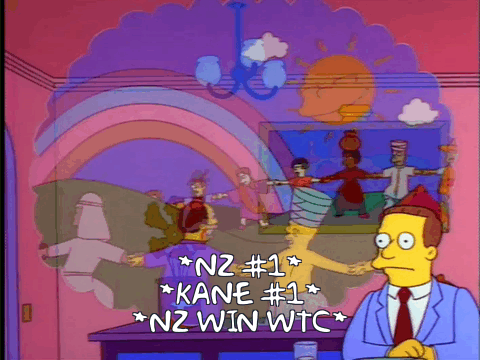SillyCowCorner1
Moooo
I honestly believe that this thread was started with Sachin at #1 in mind.
Everything tends towards Sachin
Everything tends towards Sachin
I’d have Sanga in the top 5 comfortably and I disagree with some of the workings of OP’s system but I’m glad that he put it out there tbh.
At the very least it is generating plenty of fresh discussion. CC was in a very dark phase a couple of months ago.


Nothing wrong with an editorialI honestly believe that this thread was started with Sachin at #1 in mind.
Everything tends towards Sachin
okFirst off I'd like to remind certain posters NZ usually dominate or are very credible in every sport we touch outside of inferior sports like soccer, unlike certain countries who spent 70 years or something sucking at their national religion. It's nice NZ cricket is finally catching up to our national sporting standards.
So now that I've actually thought about todays comparison properly.... (tl;dr - I am wrong)
I instinctively thought Williamson was better at first post tbh, and looking back I think it was due to the "watching both play" thing because Kane just looks every inch the God when he gets in and general eye rolling at him being demoted below the likes of Mahela Jayawardene. I posted off the cuff without really thinking about why I thought that way.
I do think Williamson is more adaptable to different game situations (off the top of my head NZ don't win in the UAE or the West Indies without him setting up the game in the 3rd innings), but he's never had a series like Dravid in England, which is the best single series I have seen from an Asian batsman outside the standard Asian batsman's element and accentuates exactly why Dravid was so valuable to an Asian side in particular (he gave us a little preview in NZ 2002 where he and Richardson showed how timeless they both are).
Dravid did have long stretches of meh though along with the bowled meme, which probably played into my initial reaction too.
I think Williamson has a higher era value compared to Dravid, because Williamson stands out from the pack more in his era compared to Dravid in his (regardless of whether you think the average bowler is better or the average batsman is worse, this is a bowling era and decks are less homogenous). Dravid's talent against the moving ball was less valuable in Dravid's era, and I think he would do a lot better in Williamson's era than most of his contemporaries, but on the data we have Williamson walks into every side in the world currently and the World XI and Dravid was a less sure thing in his era.
Overall Dravid has had the better career but I will be mildly disappointed if Williamson does not have the better career when he retires, and Williamson at 30 years old is a better batsman than Dravid at the same age imo. Happy to concede after thinking about it that right now, I am wrong.
Era value is probably the best current argument I can think of for ranking Smith #2 of all time, if you were so inclined. I think it was Teja who posted the 2011 onwards (or maybe 2016 onwards?) bowling statistics a while back. They were ridiculous, and we're seeing it reflected in the records of current batsmen. A good middle order player is back to having a 40+ career average, and if you can scrape above an average of 35 opening then congratulations enjoy 50 test matches. Then over in the corner is Steve Smith, casually averaging 60.
Era value is why I put McGrath #1 of all quicks. I should probably bump my ranking of Shaun Pollock and maybe a few others to be consistent.
 I did say a couple of months ago tbf.
I did say a couple of months ago tbf.That pic genuinely looks like someone has photo-shopped a slightly too-big pic of Kohli's melon onto a stock pic of someone playing a cover drive.No. 10
Virat Kohli - 133.7
View attachment 28427
Points: 133.7
Span: 2013-21
Peak: 2016-19
Longevity penalty: -9.9
Overall points: 143.1
Overseas points: 140.2
Best bowling attack points: 134.7
Peak points: 161.2
Runs: 7547
Average: 52.04
But the one in the good team will not play when they are in bad form, because they are replaced. So they wont have horrific runs, and would have higher averages.Good work on this thread Venky. I don't have to agree with all the rankings to appreciate a new take on things. Longevity is nice, but I have always thought there is a cutoff (not sure where it is, though) from where you can ignore a downturn in output. Statistically, that is the fault of their team not being up to scratch, rather than them tarnishing their greatness. It is a hard one to assess. Someone trying to break into a great team will miss the early years of their career and the end part, just because their position is so hard to maintain. Someone in a mediocre team can get lots of credit for longevity, that another equally good player in a great team could not.
I feel Lara would highly benefit from his methodology because of his RPI . His number of not outs were very low.I honestly believe that this thread was started with Sachin at #1 in mind.
Everything tends towards Sachin
Great theory, but not really a thing in practice. eg. Mark Waugh who was kept in the side for a while despite being in ordinary form with a lot of very good players missing out. A lot of the time it's even the opposite, you have players like Damien Martyn and Brad Haddin who languished in domestic cricket during some of their periods of best form because the team was to strong and they couldn't crack it.But the one in the good team will not play when they are in bad form, because they are replaced. So they wont have horrific runs, and would have higher averages.
You agree with him with your second point. Gilchrist, Hussey, Martyn etc honed their skills in domestic cricket under less pressure and when they were finally selected to play for Australia, they were ready for immediate success. Imagine someone like Anderson being from a country of bowling riches, he wouldn’t have been selected so early. He would have fewer wickets but better record/average.Great theory, but not really a thing in practice. eg. Mark Waugh who was kept in the side for a while despite being in ordinary form with a lot of very good players missing out. A lot of the time it's even the opposite, you have players like Damien Martyn and Brad Haddin who languished in domestic cricket during some of their periods of best form because the team was to strong and they couldn't crack it.
Yes but as I said it can work both ways. Depending on circumstances it can hurt rather than help.You agree with him with your second point. Gilchrist, Hussey, Martyn etc honed their skills in domestic cricket under less pressure and when they were finally selected to play for Australia, they were ready for immediate success. Imagine someone like Anderson being from a country of bowling riches, he wouldn’t have been selected so early. He would have fewer wickets but better record/average.
So if they were so good, why they could not crack in to the team? The sentence itself is a contradiction. The players are not picked because the selectors believe they cannot replace the current players, despite being at the form of their life. If somebody was averaging 75+ in FCC, no matter how strong the team is, there is room for such players, unless they have glaring technical deficiencies / petty politics.Great theory, but not really a thing in practice. eg. Mark Waugh who was kept in the side for a while despite being in ordinary form with a lot of very good players missing out. A lot of the time it's even the opposite, you have players like Damien Martyn and Brad Haddin who languished in domestic cricket during some of their periods of best form because the team was to strong and they couldn't crack it.
ConwaySo if they were so good, why they could not crack in to the team? The sentence itself is a contradiction. The players are not picked because the selectors believe they cannot replace the current players, despite being at the form of their life. If somebody was averaging 75+ in FCC, no matter how strong the team is, there is room for such players, unless they have glaring technical deficiencies / petty politics.
